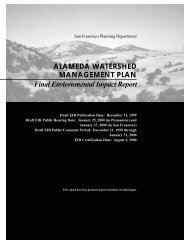Feasibility of Fish Passage at Alameda Creek Diversion Dam
Feasibility of Fish Passage at Alameda Creek Diversion Dam
Feasibility of Fish Passage at Alameda Creek Diversion Dam
You also want an ePaper? Increase the reach of your titles
YUMPU automatically turns print PDFs into web optimized ePapers that Google loves.
<strong>Feasibility</strong> <strong>of</strong> <strong>Fish</strong> <strong>Passage</strong> <strong>at</strong> <strong>Alameda</strong> <strong>Creek</strong> <strong>Diversion</strong> <strong>Dam</strong>Model 17:Model 18:Model 19:Y =α ⎛ X ⎞× ⎜β+ X⎟⎝ ⎠α+β Xδ×Y = ηφ+γ×X=α−β δXY ×( )Model 20: Y = ( α−β× X ) × 1−exp( −φ × X)δγThese models were fitted to the 1994–2004 d<strong>at</strong>a using least squares, assuming th<strong>at</strong> the residuals are normallydistributed with mean 0 and standard devi<strong>at</strong>ion σ. Table B-1 displays the values <strong>of</strong> the parameter estim<strong>at</strong>es,the estim<strong>at</strong>ed standard devi<strong>at</strong>ion <strong>of</strong> the residuals:N( σ= ˆ ∑ residual N )as well as the coefficient <strong>of</strong> determin<strong>at</strong>ion (r²) <strong>of</strong> the fits for the 20 models.i=1The best <strong>of</strong> the 20 fitted models was selected using Akaike’s Inform<strong>at</strong>ion Criteria (AIC). AIC was calcul<strong>at</strong>edusing the formula:( ˆ 2)AIC = N × ln σ + 2 × K (Burnham and Anderson, 2002),where K is the number <strong>of</strong> estim<strong>at</strong>ed parameters, and N is the sample size (i.e., N = 3,653).as the square <strong>of</strong> ˆσ .Table B-2 displays the AIC for the 20 fitted models, together with the AIC differences (i.e.,i2ˆσ was estim<strong>at</strong>edΔ AICimodel likelihoods (i.e., Λ i ) and the rel<strong>at</strong>ive model probabilities or Akaike’s weights (i.e., w i ). The modelselected as the best model for the d<strong>at</strong>a out <strong>of</strong> the 20 models corresponds to the model whose fit produced theΔ AIC = AIC − min AIC , while the modelsmallest AIC. The AIC differences were calcul<strong>at</strong>ed as ( )likelihoods were calcul<strong>at</strong>ed as:and the Akaike’s weights as:⎛ 1L iα exp ⎜−× ΔAICi⎝ 2i⎞⎟⎠i), thewi= Li20∑i = 1LiThese three additional quantities provide an insight on the rel<strong>at</strong>ive performance <strong>of</strong> each fitted model withinthe set <strong>of</strong> 20 chosen models.ACDD <strong>Passage</strong> June 2009 Page B-4








